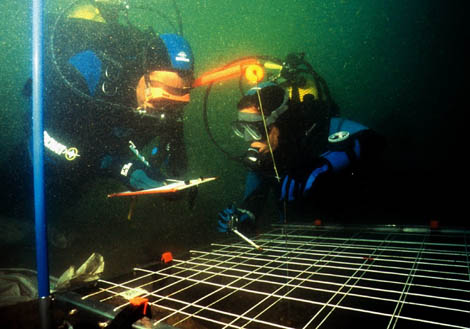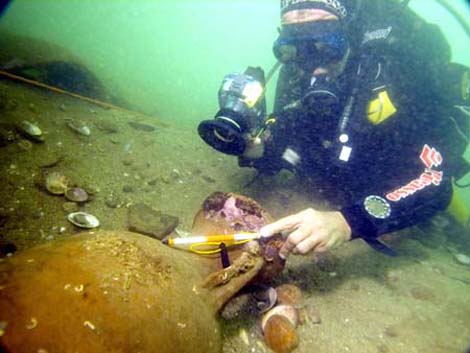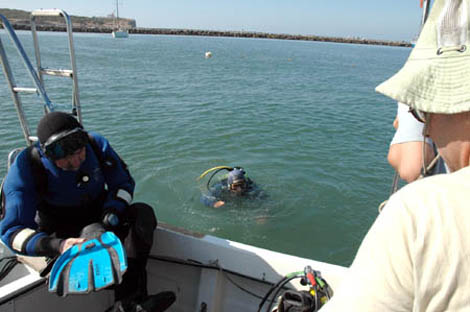 A Roman ship wrecked in the Arade estuary and a 17th century ship that sank in front of Ponta do Altar are two of the focuses of interest in the new underwater archeology campaign that should start tomorrow, the XNUMXth, in this area of the Algarve coast.
A Roman ship wrecked in the Arade estuary and a 17th century ship that sank in front of Ponta do Altar are two of the focuses of interest in the new underwater archeology campaign that should start tomorrow, the XNUMXth, in this area of the Algarve coast.
It should because, as he explained to the Sul Informação archaeologist Cristóvão Fonseca, one of those responsible for the campaign, the strike in the port of Lisbon is delaying the researchers' plans. Its diving and image collection equipment has already arrived from the Azores, where they were in the last few weeks on another project, but has not yet left the ship that transported it…
Basically, everything has to do with ships.
Whenever it starts, the underwater archeology campaign will run until October 31st, in the estuary and mouth of the Arade river. This intervention is promoted by the Center for Overseas History (CHAM) of the Faculty of Social and Human Sciences of Universidade Nova de Lisboa and coordinated by archaeologists Cristóvão Fonseca and José Bettencourt, with the support of the Museum of Portimão, General Directorate of Cultural Heritage, Naval Club of Portimão, Underwater Diving Club Portisub, Subnauta Diving Center and Archeosfera Lda.
“In all, it will be two weeks of intense work, to make the first systematic approach to underwater archaeological sites that have been known for some time, but which have not yet been thoroughly investigated, with an archaeological survey as it should be”, explained Cristóvão Fonseca.
On a permanent basis, between CHAM archaeologists, technicians from the Portimão Museum and other divers from the other entities, will be working in the «six to eight people» area.
"This is a project that we started this year, but it will be continued in the next one," he added. The project is called «Between the Mediterranean and the Atlantic: an approach to the underwater cultural heritage of the Arade river estuary».
Roman ship wrecked?
 In these two weeks, the investigation will undergo visual prospecting, registration and survey, focusing on the archaeological sites called Ponta do Altar A and B, GEO 5 and Arade B/GEO 7, which correspond to shipwreck and anchorage contexts, whose chronology encompasses from the Roman period to the contemporary period.
In these two weeks, the investigation will undergo visual prospecting, registration and survey, focusing on the archaeological sites called Ponta do Altar A and B, GEO 5 and Arade B/GEO 7, which correspond to shipwreck and anchorage contexts, whose chronology encompasses from the Roman period to the contemporary period.
In the preliminary surveys carried out in previous years at the site called Arade B/GEO 7, located in the interior of the Arade estuary, it was determined that this site has a «vast chronology, from Roman to modern times».
But what arouses most interest are the remains of a Roman vessel. There, entire amphorae were discovered, «all of the same type, indicating that they came from the same area». This, according to the archaeologist, may indicate that it is either an anchorage area, and that the amphorae, once empty, were thrown away, "like lost tare", or that it is a site where a Roman vessel sank. . And confirming this, stresses Cristóvão Fonseca, “would be very important at the national level, because there are few known contexts for the sinking of Roman vessels in Portugal”.
O mystery it may not yet be clarified in this short two-week campaign, but the archaeologist points out that "in the next campaigns there will be surveys and archaeological excavations, which could provide clues to clarify this site".
And because at the bottom of rivers, as on the earth's surface, there are many layers that history leaves behind, in this same place there are still traces of a shipwreck from the modern era, with wood, pulleys and objects. But here, as it is located more on the surface, these remains have already been «partially affected» by the dredging in the port of Portimão, which turned over the layers of the riverbed, mixed the objects, «complicating the interpretation».
Bronze cannons of a ship from the time of the Philips
Outside the estuary, at the mouth of the Arade, in front of the Farol Ponta do Altar (Ferragudo), is the second of the four archaeological sites to arouse greater interest in this underwater research campaign.
The Ponta do Altar B site has been known since 1992, when the team from the then National Center for Nautical and Underwater Archeology, headed by archaeologist Francisco Alves, raised some bronze cannons from this site, bearing the Portuguese weapons and those of the Spanish crown.
The profusion of cannons indicates the probable sinking of a warship, from the time when the crowns of Portugal and Spain were united under the rule of the Filipes. Cristóvão Fonseca says that the ship wrecked there must date from the «beginnings of the XNUMXth century», but only further archaeological research can help confirm this dating.
There, in the 90s, the cannons that were visible and could be stolen were recovered. “But it is necessary to understand the site better, interpret it better, possibly carrying out surveys and excavations in areas with more potential”, stresses the underwater archaeologist.
Project almost at no cost
 Cristóvão Fonseca, who is well acquainted with the wealth of the Arade as an underwater archeological potential, having already been responsible for the extinct Nucleus of Underwater Archeology at the Portimão Museum, is keen to emphasize the importance of collaboration between all entities, public and private, which got involved in the project. “We managed to gather synergies to be able to carry out this project at almost zero cost”, he stressed.
Cristóvão Fonseca, who is well acquainted with the wealth of the Arade as an underwater archeological potential, having already been responsible for the extinct Nucleus of Underwater Archeology at the Portimão Museum, is keen to emphasize the importance of collaboration between all entities, public and private, which got involved in the project. “We managed to gather synergies to be able to carry out this project at almost zero cost”, he stressed.
All so that «underwater archaeological research is carried out on the Arade River again», which, between 2003 and 2005, was even the target of systematic campaigns, involving a vast team with links to foreign universities. This time, the Overseas History Center of the Faculty of Social and Human Sciences of Universidade Nova de Lisboa will coordinate the operations.
The mouth of the Arade river is a natural harbor of shelter, which serves the various urban centers, namely Portimão, as well as an important means of navigation, communication and penetration into the interior of the Barlavento Algarvio, a reality that is widely documented by written sources and by several archaeological remains identified in recent decades.
Recognition of the underwater archaeological potential of the Arade River estuary dates back at least to the 1970s, with interventions carried out between 1993 and 2007 in archaeological contexts decisively contributing to the assertion of its scientific and heritage value, having been promoted by the National Museum of Archeology, National Center for Nautical and Underwater Archeology, Museum of Portimão, Group of Oceanic Studies, Institute of Nautical Archeology / Texas A&M University and Museum of Anthropology and Ethnology of the University of São Paulo.


















Comments